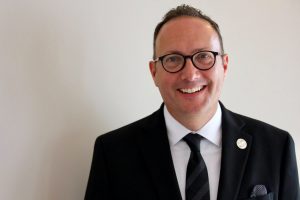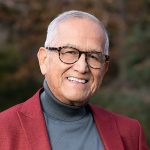
Songbook Foundation executive director Chris Lewis – Courtesy of The Great Songbook Foundation. Used with permission.
Next week, I am covering public events of the Songbook Academy, a weeklong, national summer intensive for talented vocalists, sponsored by the Great American Songbook Foundation, co-founded by five-time Grammy nominee Michael Feinstein. The events include a masterclass on July 18, a showcase on the 20th, and a concert on the 22nd, all of which will be held at the Palladium on the campus of The Center for the Performing Arts in Carmel. The 40 finalists from 15 states will be guided during the week by noted mentors and music educators as they rehearse and perform jazz, pop, Broadway, and Hollywood standards.
In advance of the Academy, Chris Lewis, the executive director of the Songbook Foundation reached out to ask me if I would like to tour the organization’s archives, which is housed in an 8,000 square foot building space located off the beaten path in a non-descript Carmel office park near the Center. The archives are another major educational program of the organization, whose mission is to preserve and promote the Great American Songbook.
During the tour, which was led by executive director, Chris Lewis, and Emily Rapoza, the director of library and archives, I was shown such artifacts as gowns worn by Ella Fitgerald, Soviet Bone records, original early drafts of “The Music Man” from the Meredith Willson collection, Sammy Davis Jr.’s traveling trunks and his musical arrangements, Jimmy Durante’s hat, a snow globe given to Rosemary Clooney by Irving Berlin after finishing “White Christmas,” Harold Arlen‘s piano on which he wrote “Over The Rainbow” from “The Wizard of Oz” and even Vincente Minnelli’s Academy Award (on loan from his daughter Liza) for directing the film “Gigi.” So that I may say that I once held an Oscar, I donned gloves at Rapoza’s request prior to her allowing me to pick up the precious item. I marveled at its heavy weight as I hoisted it in the air during my imagined acceptance speech.
Below is an edited transcript of my conversation with Chris that took place outdoors at a table in front of the archives building, following the tour.
I understand a museum holding all your artifacts will eventually be constructed. Was that the Foundation’s and Feinstein’s goal from the very beginning?
From the very beginning. There is the Cleveland Rock & Roll Hall of Fame and the Country Music Hall of Fame and Museum in Nashville but no museum for American Popular Music. But that has been the long-term goal and dream, and we talked about it since day one. Starting the Foundation would lead to a museum. Currently, we are in the process of talking about a museum and planning for one and looking for museum locations. I always clarify that we are already a small museum, recognized by the American Alliance of Museums. We have spent the last 13 years building a museum, building our programs, building our collections, building our research opportunities. What we are doing now is getting ready to construct a building. When the Palladium was built there was talk about a museum as part of the campus or near it, so it has always been a dream.
Where will the museum be located?
We are looking at Carmel which has been our home for a long time, but we have been approached by entities in Indianapolis, so we have been exploring options there, too. We certainly have no designs to leave this area. We have been a cultural affiliate of the Grammy Museum since 2017, and last year we engaged them as museum consultants. They are guiding us through this process. We thought we would have to explain to them why we want to build a museum in Indiana, but they said, “You are the perfect place for a museum about the American Songbook.” The music does not belong to one coast or another. The composers themselves were from everywhere. Hoagy Carmichael and Cole Porter are from Indiana, Gus Kahn is from Chicago, Richard A. Whiting is from Detroit, Johnny Mercer is from Savannah. The American Songbook represents all of America and where else should the museum be but the crossroads of America? You can be anywhere in the country in four hours by plane. We will be a destination. Who would have thought the Rock & Roll Hall of Fame would be in Cleveland? Who would have thought that was a good idea 30 years ago? We just want to do our due diligence and make the best decision for the museum. We want to be somewhere where we are going to attract the most people and be an asset to the community, so we have engaged professionals to help us do that.
Is there a timeline?
We are not locked into anything, but we are well into the process. We are working on facility matrixes. We are working on how much space we need, what kind of space. We are already down that road, choosing a location which we hope to select in the next few months. That will initiate everything else.
So an announcement is forthcoming within the coming year?
Oh, sure.
I presume the Foundation is following a strategic plan?
Sure, we absolutely do have a strategic plan. Our goal is to be a leading authority on the Great American Songbook. We know we cannot house everything. We are not the Library of Congress. We do know, outside the Library of Congress, we are — if not the largest — the second largest repository anywhere in the world totally dedicated to this topic and genre. We know we cannot house everything, but we can be the point of access, and that is what we are doing. We host academic conferences; we work with researchers all over the world. Our materials just this year alone have been used in books, films, and recordings. That is our goal. Everything else is related to that core mission. Education programs — for this music and history to remain relevant and viable, the next generation has to hear about it or learn about it, so that is why the Songbook Academy exists. The archives here, this is the heart of what we do. Where you are now is the nerve center. This is why we were founded. This is the interest of Michael — to preserve the legacies of the songwriters and make sure their materials, their stories, and their music are preserved and kept. That’s why we exist. Everything else is the education, the exhibits, again, part of our education strategy. We have the exhibit at the Palladium, and we have travelling exhibits. Right now, they are all over the country in places like Texas, Louisiana, and Iowa. We are telling the story of the Songbook, and we are doing it through the eyes of our collection, and we are still growing. When I say we are one of the largest, we are not huge, but we do have 500,000 items. Right now, our travel exhibits are free to loan and if it is out of state, you just need to cover the shipping, but it is part of our mission to make them available to schools and offices. No artifacts — they are all graphic-based exhibits. Not installations. We provide a pack of information with videos on how to install and care for them and shipping information.
How do people learn about the archives?
Through our promotion efforts and our programs. You were instrumental in making the Songbook a national program and becoming nationally recognized through your reviews and your writing. That helped us in those early days, but now that program is 14 years old. We have alumni who are on Broadway and in movies and television and concert performances, and so they are spreading the world. We have an alumni network. We have a huge social media presence. We are here in Indiana, but we are a national organization. We have a YouTube series called “In the Archives” with Michael Feinstein, with 15-minute episodes. Those premiere every month and when we go through our platform and Michael’s social media outlets, we can have hundreds and thousands of views on those. We are hosting our third “Stage Struck” conference this spring. This is a conference of researchers and academics from all over the world. Last time we held it two years ago, we had ten countries represented here. All are focused on a specific topic, but what it does is make a go-to place for research about the Songbook, about music. We work with the Library of Congress on projects, or they will call us about collections that they cannot take, and we do the same. So we raised our profile in the industry, and then donors hear about us through media, throughout promotional efforts and our programs.
Have you received national press?
There have been pieces through the years that talk about us. As far as the museum is concerned, we have not publicly announced that yet, and I do expect we’ll get some attention from that. We have gotten some nice features from major outlets. The partnership with Forte Sports Medicine and Orthopedics was the cover story with the “IndyStar” and it got picked up by the Gannett network and appeared in outlets across the country. Do I want more? Of course. We also just received a significant grant from a donor specifically for public relations to help us brand ourselves with the museum and mount a national campaign.
Let us shift topics. What has all this meant to you?
It has been lifechanging. Not to be too dramatic about it, but I really feel like I found my calling. I always tell people that I got to create my dream job. Some people aspire and see their dream job, but I was able to create mine. I was a performer. I love music. I love history. I went back to school and received my master’s in education and was teaching history. I was using music in my classroom, and when I heard about the foundation, something clicked. I knew Michael in New York City a little bit. I was a fan of his music, and when I read that he started a foundation, I thought “Oh my God, there’s so much potential there.” It never occurred to me that something like this even needed to exist. I was not thinking of it in terms of historical perspective. Another weird connection: I had worked on a film. My wife had a friend in New York. She is from Indiana and went to high school at North Central. One of her friends from North Central was living there and was a new filmmaker. She’d made a documentary about what it takes to put on an election. She followed the clerk of Marion County, who was Doris M. Sadler, the first artistic director of the Foundation. So when I saw that Michael had started the Foundation, I heard about it from my in-laws who live in Indiana, and I read about it, and she was listed as the executive director. I called and said, “Hey if you ever need a teacher or a museum educator, or if there is anything I can do, let me know.” She told me about the Songbook Academy which started in 2009. At that time, they did a day or weekend event. It was not what it is today. It was held at the University of Indianapolis and then Butler and then it went dormant when they moved into the Palladium. She started talking to me, and it took a little while campaigning. I would send lesson plans. I said, “A teacher could teach a lesson on the Great Depression and use this music.” Or “You could teach a lesson about Civics, and this is how I would use music in my classroom.” I was campaigning for the job, and she called and said, “We want to do this education program. Could you come and revive it and expand it nationally?”
It sounds like you were proactive, if not gutsy.
I thought I was going to be a teacher. I loved New York. I never dreamed of leaving New York. I just thought there was so much potential to grow. I learned so much. I felt like I got to go back to graduate school again and again and again. I joke now that I have worked at the Center all these years, and I have more titles than anyone because my title has changed so many times over the years. I started with the Songbook Academy and that was quite a journey reviving and then expanding it nationally into a week at the Center. Then, I became the director of education and then director of programs. From that, we built other programs and then exhibits, the Perfect Harmony program, and then in 2017 our previous executive director, Karen Kelsey retired. She had been my mentor. She recommended me and helped move me into this role, and it has been amazing.
What were you doing prior to going back to school?
I was a performer for years. I was an actor. I am primarily a singer, and then I got hired to be in a professional vocal jazz group called Pieces of Eight, and we had agents in New York, and I worked with them for eight years and Kelley (his wife) and I were friends. I got her into the group, and we travelled the country with this group. The group later disbanded. Kelley and I wanted to get married and have kids.
When you changed careers, was it for practical reasons?
Some of it was practical, but I had other passions. I felt like I had a certain level of success that was fulfilling, but the life of an artist, especially if you want a family, was not. Teaching was something I had thought about for a long time, and I had some friends in the city who had transitioned into education, so I pursued it. I have to say I was inspired and fulfilled by teaching in a way I had never been.
You are still teaching, aren’t you?
That is why I call this my dream job because it fulfills all those things. I am still a performer. You see me. I get to be on stage. I get to be on camera. I am an emcee. I am teaching because I work with the students one on one.
Is being close to celebrities and fame a perk of your job?
When we said we were moving here, so many of our friends said, “You are going where?” I have to say if I moved here and was teaching or something else, it would be a different story. I moved here when this first opened, and from day one, my friends started texting, “Where are you? You were with Bernadette Peters last night? How did that happen?” In so many ways, I am more surrounded by the arts and celebrity here than I ever was in New York.
Is there anything more the Foundation hopes to pursue?
We have no shortage of great ideas. Our staff is growing. In the last two years, we have doubled it to six. Seven if you count me. However, we must be mindful and strategic in everything we do. We cannot chase every good idea. We had a brainstorming session yesterday. Just in the education world there are so many things we want to do.
What does the future of the Foundation look like from your viewpoint?
I’m more excited about the future of the Songbook Foundation than ever before. Our collections are growing, and we are sharing them with researchers, authors, and filmmakers across the world. Our exhibits and programs like the Songbook Academy and Perfect Harmony are reaching people across the country. And now, plans have begun on a world-class museum celebrating the American Songbook. Exciting things are ahead for the Foundation.
For more about The Great American Songbook Foundation and its programs visit thesongbook.org. Visits to the archives are by appointment only and can be made by contacting info@TheSongbook.org.
.





